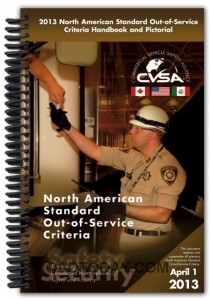 The Commercial Vehicle Safety Alliance (CVSA) has announced that the 2013 North American Standard Out-of-Service Criteria Handbook and Pictorial (OOSC), which goes into effect on April 1st, 2013, is now available. The OOSC, the only official reference book of its kind for law enforcement and the motor carrier industry, is a valuable tool designed to improve commercial motor vehicle safety by promoting uniformity in compliance and enforcement throughout North America.
The Commercial Vehicle Safety Alliance (CVSA) has announced that the 2013 North American Standard Out-of-Service Criteria Handbook and Pictorial (OOSC), which goes into effect on April 1st, 2013, is now available. The OOSC, the only official reference book of its kind for law enforcement and the motor carrier industry, is a valuable tool designed to improve commercial motor vehicle safety by promoting uniformity in compliance and enforcement throughout North America.
This reference tool is designed to improve commercial motor vehicle safety through uniformity in compliance and enforcement throughout North America. Specifically, it identifies Critical Vehicle Inspection Item violations during a roadside inspection that can prohibit a motor carrier or operator from driving or operating a commercial motor vehicle for a specified period of time or until the defective condition is corrected.
CVSA has maintained, updated and published the North American Standard Out-of-Service Criteria annually for more than twenty years. It is heavily relied upon by highly qualified, specially trained and certified state, provincial, territorial and federal law enforcement personnel in identifying Critical Vehicle Inspection Item violations during a roadside inspection. These violations can prohibit a motor carrier or operator from driving or operating a commercial motor vehicle for a specified period of time or until the defective condition is corrected.
Specifically, the 2013 North American Standard Out-of-Service Criteria Handbook and Pictorial includes…
- Part I—Detail violations which place a driver out-of-service.
- Part II—Outline the Critical Vehicle Inspection Items and provides direction to each commercial vehicle inspector in North America identifying at what point a commercial motor vehicle can no longer be safety operated for fear of causing an accident or breakdown, due to its mechanical condition.
- Part III—Provide guidance for unsafe hazardous materials transportation, including both conditions which fail to communicate a hazard and those which are themselves hazards.
- Part IV—Establish criteria for placing a motor carrier out-of-service.


